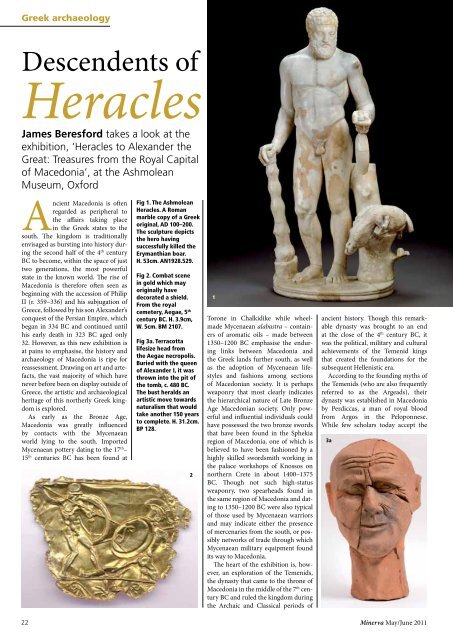Cult of beauty - Minerva
Cult of beauty - Minerva
Cult of beauty - Minerva
Create successful ePaper yourself
Turn your PDF publications into a flip-book with our unique Google optimized e-Paper software.
Greek archaeology<br />
Descendents <strong>of</strong><br />
Heracles<br />
James Beresford takes a look at the<br />
exhibition, ‘Heracles to Alexander the<br />
Great: Treasures from the Royal Capital<br />
<strong>of</strong> Macedonia’, at the Ashmolean<br />
Museum, Oxford<br />
Ancient Macedonia is <strong>of</strong>ten<br />
regarded as peripheral to<br />
the affairs taking place<br />
in the Greek states to the<br />
south. The kingdom is traditionally<br />
envisaged as bursting into history during<br />
the second half <strong>of</strong> the 4 th century<br />
BC to become, within the space <strong>of</strong> just<br />
two generations, the most powerful<br />
state in the known world. The rise <strong>of</strong><br />
Macedonia is therefore <strong>of</strong>ten seen as<br />
beginning with the accession <strong>of</strong> Philip<br />
II (r. 359–336) and his subjugation <strong>of</strong><br />
Greece, followed by his son Alexander’s<br />
conquest <strong>of</strong> the Persian Empire, which<br />
began in 334 BC and continued until<br />
his early death in 323 BC aged only<br />
32. However, as this new exhibition is<br />
at pains to emphasise, the history and<br />
archaeology <strong>of</strong> Macedonia is ripe for<br />
reassessment. Drawing on art and artefacts,<br />
the vast majority <strong>of</strong> which have<br />
never before been on display outside <strong>of</strong><br />
Greece, the artistic and archaeological<br />
heritage <strong>of</strong> this northerly Greek kingdom<br />
is explored.<br />
As early as the Bronze Age,<br />
Macedonia was greatly influenced<br />
by contacts with the Mycenaean<br />
world lying to the south. Imported<br />
Mycenaean pottery dating to the 17 th –<br />
15 th centuries BC has been found at<br />
22<br />
Fig 1. The Ashmolean<br />
Heracles. A Roman<br />
marble copy <strong>of</strong> a Greek<br />
original, AD 100–200.<br />
The sculpture depicts<br />
the hero having<br />
successfully killed the<br />
Erymanthian boar.<br />
H. 53cm. AN1928.529.<br />
Fig 2. Combat scene<br />
in gold which may<br />
originally have<br />
decorated a shield.<br />
From the royal<br />
cemetery, Aegae, 5 th<br />
century BC. H. 3.9cm,<br />
W. 5cm. BM 2107.<br />
Fig 3a. Terracotta<br />
lifesize head from<br />
the Aegae necropolis.<br />
Buried with the queen<br />
<strong>of</strong> Alexander I, it was<br />
thrown into the pit <strong>of</strong><br />
the tomb, c. 480 BC.<br />
The bust heralds an<br />
artistic move towards<br />
naturalism that would<br />
take another 150 years<br />
to complete. H. 31.2cm.<br />
BP 128.<br />
2<br />
1<br />
Torone in Chalkidike while wheelmade<br />
Mycenaean alabastra – containers<br />
<strong>of</strong> aromatic oils – made between<br />
1350–1200 BC emphasise the enduring<br />
links between Macedonia and<br />
the Greek lands further south, as well<br />
as the adoption <strong>of</strong> Mycenaean lifestyles<br />
and fashions among sections<br />
<strong>of</strong> Macedonian society. It is perhaps<br />
weaponry that most clearly indicates<br />
the hierarchical nature <strong>of</strong> Late Bronze<br />
Age Macedonian society. Only powerful<br />
and influential individuals could<br />
have possessed the two bronze swords<br />
that have been found in the Sphekia<br />
region <strong>of</strong> Macedonia, one <strong>of</strong> which is<br />
believed to have been fashioned by a<br />
highly skilled swordsmith working in<br />
the palace workshops <strong>of</strong> Knossos on<br />
northern Crete in about 1400–1375<br />
BC. Though not such high-status<br />
weaponry, two spearheads found in<br />
the same region <strong>of</strong> Macedonia and dating<br />
to 1350–1200 BC were also typical<br />
<strong>of</strong> those used by Mycenaean warriors<br />
and may indicate either the presence<br />
<strong>of</strong> mercenaries from the south, or possibly<br />
networks <strong>of</strong> trade through which<br />
Mycenaean military equipment found<br />
its way to Macedonia.<br />
The heart <strong>of</strong> the exhibition is, however,<br />
an exploration <strong>of</strong> the Temenids,<br />
the dynasty that came to the throne <strong>of</strong><br />
Macedonia in the middle <strong>of</strong> the 7 th century<br />
BC and ruled the kingdom during<br />
the Archaic and Classical periods <strong>of</strong><br />
ancient history. Though this remarkable<br />
dynasty was brought to an end<br />
at the close <strong>of</strong> the 4 th century BC, it<br />
was the political, military and cultural<br />
achievements <strong>of</strong> the Temenid kings<br />
that created the foundations for the<br />
subsequent Hellenistic era.<br />
According to the founding myths <strong>of</strong><br />
the Temenids (who are also frequently<br />
referred to as the Argeads), their<br />
dynasty was established in Macedonia<br />
by Perdiccas, a man <strong>of</strong> royal blood<br />
from Argos in the Peloponnese.<br />
While few scholars today accept the<br />
3a<br />
<strong>Minerva</strong> May/June 2011

















